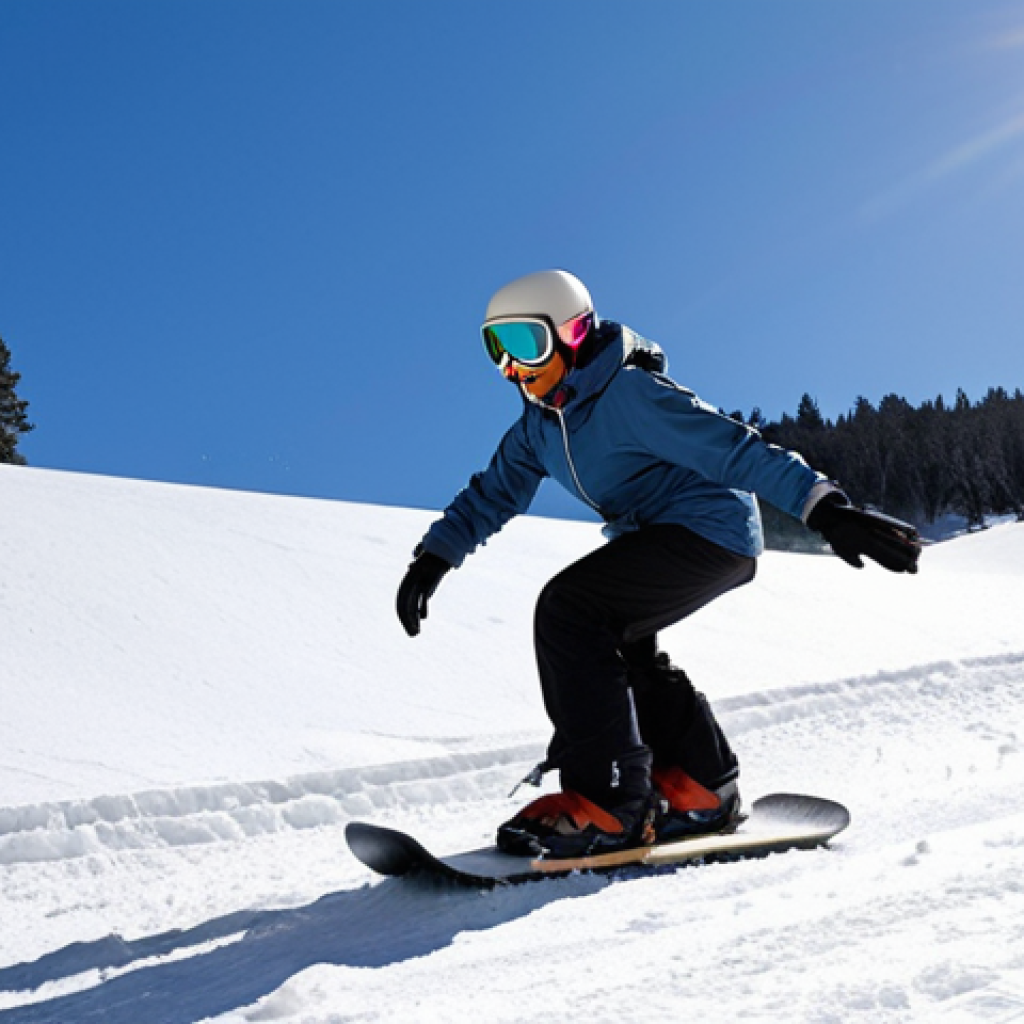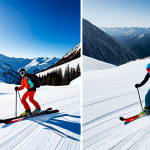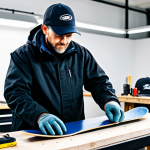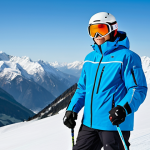Alright, hitting the slopes with your snowboard is a total blast, but let’s be real, safety first! I’ve seen way too many wipeouts that could’ve been avoided with a little pre-planning and know-how.
As snowboarding evolves, so do the risks. New terrain parks, innovative board designs, and a growing number of riders mean we need to be extra vigilant.
From properly fitting your gear to understanding the conditions, it’s all about making smart choices. Plus, with the rise of AI-powered safety tech in sports gear, there’s never been a better time to prioritize your well-being on the mountain.
So, let’s dive in and make sure you’re shredding safely! Let’s get the lowdown in the article below!
Alright, let’s get started.
Carving Confidence: Mastering Stance and Balance
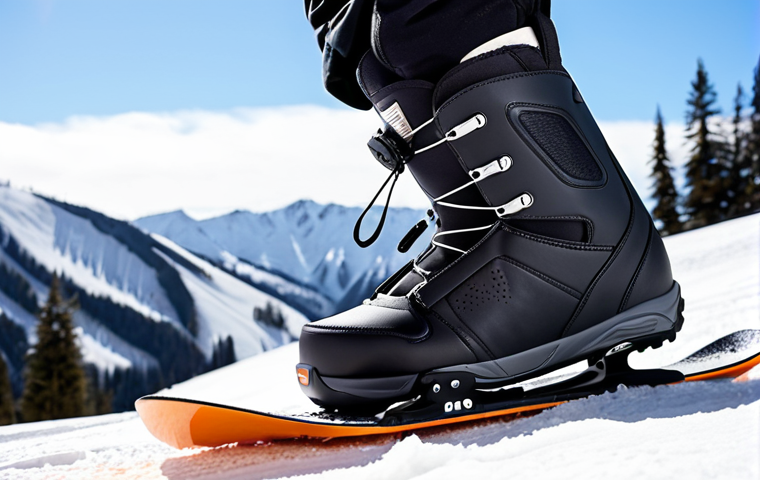
Snowboarding isn’t just about bombing down the hill; it’s about controlling your ride. Your stance is your foundation. I remember when I first started, my buddy, a seasoned snowboarder, told me, “If your stance is off, everything else will be too.” Boy, was he right!
Dialing in Your Duck Stance
Experiment with your stance width and angles. Most beginners start with a duck stance, where both feet point slightly outward. I’ve found that a slightly wider stance gives you more stability, especially when you’re learning to link turns.
Keep tweaking those angles until you feel balanced and comfortable, as this is one of the most important steps.
The Art of Weight Distribution
Weight distribution is key. I see so many beginners leaning too far back, which makes it nearly impossible to control your board. Practice bending your knees and keeping your weight centered over the board.
Pretend you’re trying to touch your shins to the front of your boots.
Practicing on Gentle Slopes
Find a nice, wide, gentle slope and practice making small turns. Focus on shifting your weight from edge to edge. Don’t be afraid to fall!
Everyone does. The key is to get back up and keep practicing. When I was learning, I spent hours on the bunny hill, just getting a feel for how my board responded to different movements.
It was tedious at times, but it paid off big time.
Gear Up for Success: Ensuring Proper Equipment Fit
Your gear is your lifeline on the mountain. Ill-fitting boots, a wobbly binding, or a helmet that’s too loose can turn a fun day into a painful one real quick.
I’ve seen it happen more times than I can count.
Boots That Fit Like a Glove
Your boots should fit snugly, but not too tight. When you stand up in them, your toes should just barely touch the end. When you flex forward, your heel should stay locked in place.
If your heel lifts, the boots are too big. I always recommend going to a reputable snowboard shop and having a professional help you find the right fit.
Binding Adjustments: A Must-Do
Bindings are what connect you to your board, so make sure they’re properly adjusted. Your boots should fit snugly into the bindings, with no excessive play.
Adjust the straps so they’re snug but not cutting off your circulation.
Helmet and Protection: Non-Negotiable
I don’t care how “uncool” you think they are, helmets are essential. A good helmet can literally save your life. Make sure it fits snugly and covers your forehead.
I also recommend wrist guards, knee pads, and padded shorts, especially when you’re learning new tricks.
Reading the Mountain: Understanding Conditions and Hazards
The mountain is a dynamic environment, and conditions can change in an instant. Being aware of your surroundings and understanding the potential hazards is crucial for staying safe.
Weather Watch: Stay Informed
Check the weather forecast before you head up the mountain. Pay attention to temperature, wind speed, and visibility. If the weather looks bad, it’s better to stay home than risk getting caught in a blizzard or whiteout.
Terrain Awareness: Know Your Limits
Be honest with yourself about your skill level. Don’t attempt runs that are beyond your ability. Start with the easier runs and gradually work your way up to more challenging terrain.
Always be aware of obstacles such as trees, rocks, and other riders.
Avalanche Awareness: Staying Safe in the Backcountry
If you’re planning on venturing into the backcountry, avalanche awareness is absolutely critical. Take an avalanche safety course, learn how to use an avalanche transceiver, shovel, and probe, and always ride with a buddy.
Never underestimate the power of an avalanche.
Ride Smart, Not Hard: Following the Skier’s Responsibility Code
The Skier’s Responsibility Code is a set of guidelines designed to promote safety on the slopes. It’s not just a bunch of rules; it’s common sense.
Know Your Responsibilities
Be aware of the people around you. When overtaking someone, do it in a safe manner and give them plenty of room. Never stop in a place where you might obstruct the trail or be hidden from view.
Always yield to uphill traffic.
Avoiding Collisions: Stay Alert
Collisions are one of the biggest causes of injuries on the slopes. Stay alert and be aware of your surroundings. Look uphill before starting down a run, and always maintain a safe speed.
If you see someone in trouble, stop and offer assistance.
Respecting Others: Courtesy on the Slopes
The slopes are a shared space, so treat others with respect. Don’t cut people off, don’t spray snow on them, and don’t be a jerk. A little courtesy goes a long way toward making the mountain a more enjoyable place for everyone.
First Aid Fundamentals: Preparing for the Unexpected
Even with the best preparation, accidents can happen. Knowing basic first aid can help you assist yourself or others in an emergency.
Essential First Aid Skills
Learn how to treat common snowboarding injuries such as sprains, fractures, and dislocations. Know how to recognize the signs of hypothermia and frostbite, and how to treat them.
Familiarize yourself with CPR and basic life support techniques.
Building a First Aid Kit
Carry a small first aid kit with you whenever you go snowboarding. Include items such as bandages, antiseptic wipes, pain relievers, and a space blanket.
It’s also a good idea to include a whistle, a multi-tool, and a small flashlight.
Knowing When to Call for Help
Don’t hesitate to call for help if someone is seriously injured. Know the emergency contact number for the ski resort you’re visiting, and be prepared to provide accurate information about the location and nature of the injury.
The Buddy
Snowboarding with a buddy isn’t just more fun; it’s also safer. Having someone to watch your back can make all the difference in an emergency.
Benefits of Riding Together
A buddy can help you spot hazards, provide assistance if you get injured, and call for help if necessary. They can also offer encouragement and motivation when you’re learning new tricks.
Staying in Contact
Make sure you and your buddy have a way to communicate with each other. Cell phones are great, but they don’t always work in remote areas. Consider using walkie-talkies or two-way radios.
Planning Ahead
Before you head out, discuss your plans with your buddy. Decide on a route, set a meeting point, and agree on a check-in time. Make sure you both know what to do in case of an emergency.
Fitness on the Snow: Physical Conditioning
| Aspect | Description | Why It Matters |
|———————-|——————————————————————————————————————|———————————————————————————————————————————————————————|
| Cardiovascular Fitness | Ability of the heart and lungs to supply oxygen to working muscles.
| Improves endurance, reduces fatigue, and allows you to ride longer and harder. |
| Strength Training | Building and maintaining muscle mass. | Provides stability, power, and reduces the risk of injury.
|
| Flexibility | Range of motion in your joints. | Improves balance, agility, and reduces the risk of muscle strains and sprains. |
| Balance and Coordination | Ability to maintain equilibrium and control your movements.
| Improves board control, reduces the risk of falls, and allows you to perform more advanced tricks. |Staying in good physical shape is essential for snowboarding safely and effectively.
Snowboarding requires a combination of strength, endurance, balance, and flexibility. Improving your fitness level can help you ride longer, avoid injuries, and have more fun on the slopes.
Targeted Exercises
Specific exercises to target the muscles used in snowboarding. Squats, lunges, and calf raises will strengthen your legs. Core exercises such as planks and Russian twists will improve your balance and stability.
Stretching exercises such as hamstring stretches and hip flexor stretches will increase your flexibility.
Pre-Season Preparation
Start training several weeks or months before the snowboarding season begins. This will give your body time to adapt to the demands of the sport. Focus on building a solid foundation of strength, endurance, balance, and flexibility.
On-Mountain Warm-Up
Before you hit the slopes each day, take some time to warm up your muscles. Do some light cardio exercises such as jogging in place or jumping jacks. Perform some dynamic stretches such as leg swings and arm circles.
This will help to prevent injuries and improve your performance. Conquering the mountain on a snowboard is about more than just the thrill; it’s about preparedness, respect, and understanding.
By focusing on your stance, gear, awareness, and physical conditioning, you’ll transform from a beginner into a confident rider ready to embrace any challenge the mountain throws your way.
Wrapping Up
So there you have it! Snowboarding is a blast, but it’s also a sport that demands respect and preparation. Nail your stance, get the right gear, understand the mountain, and always prioritize safety. See you on the slopes!
Handy Tips
Here are a few extra nuggets of wisdom I’ve picked up over the years:
1. Invest in quality base layers. They’ll keep you warm and dry all day long.
2. Always carry sunscreen and lip balm with SPF. The sun is intense at high altitudes.
3. Take breaks when you need them. It’s better to rest and recharge than to push yourself too hard and risk injury.
4. Consider taking a lesson from a certified instructor. They can provide personalized guidance and help you improve your technique.
5. Don’t be afraid to try new things! Snowboarding is all about pushing your limits and having fun.
Key Takeaways
Okay, let’s quickly recap the most important things to remember:
Stance & Balance: Dial in your duck stance, distribute your weight correctly, and practice on gentle slopes.
Gear: Ensure your boots fit, adjust your bindings, and always wear a helmet.
Mountain Awareness: Check the weather, know your limits, and be aware of avalanche risks.
Responsibility Code: Be aware of others, avoid collisions, and respect fellow riders.
Fitness: Stay physically fit to avoid injuries and enjoy longer days on the slopes.
Frequently Asked Questions (FAQ) 📖
Q: What’s the most important thing to check before hitting the slopes on my snowboard?
A: Honestly, the most important thing is making sure your gear fits properly. I’ve seen so many people with boots that are too loose or bindings that aren’t adjusted right.
It’s like trying to drive a car with flat tires! Get a professional fitting, especially for your boots. Ill-fitting gear can totally ruin your day and, more importantly, increase your risk of injury.
Also, give your board a quick tune-up, wax it, and check the edges!
Q: I’m hearing more about
A: I in snowboarding gear. What’s the deal with that? A2: Yeah, it’s pretty wild, isn’t it?
Think of things like helmets with built-in sensors that can detect a hard fall and automatically alert emergency services, or even bindings that adjust to your riding style.
Some companies are even developing AI-powered apps that analyze your runs and give you personalized feedback on your technique. It’s all about leveraging technology to make snowboarding safer and more enjoyable.
It’s still kinda new, but it’s definitely something to keep an eye on. I mean, who wouldn’t want a helmet that calls for help when you’re knocked out after a nasty spill, right?
Q: Aside from gear, what else can I do to improve my safety on the slopes?
A: Beyond the gear, awareness is key. Check the weather report and avalanche conditions before you go. Seriously, don’t be a hero and ignore warnings.
Also, warm up properly! Think of your muscles like a rubber band; if you try to stretch them when they’re cold, they’re going to snap. And listen to your body.
If you’re tired, take a break. It’s way better to chill out for a bit than to push yourself too hard and end up with a tweaked knee or worse. Plus, knowing basic first aid and having a buddy system can make a huge difference in case something does go wrong.
📚 References
Wikipedia Encyclopedia
